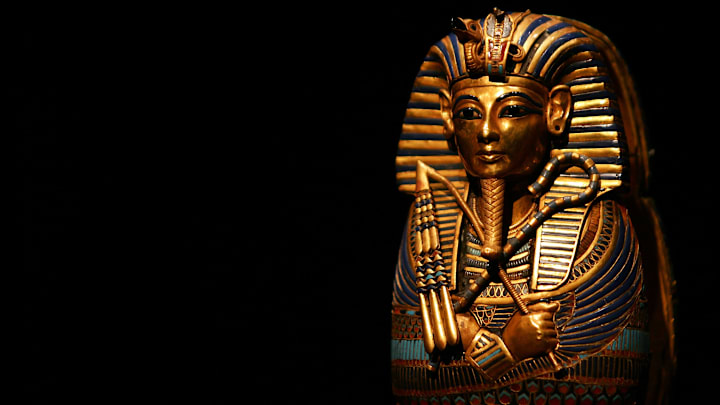He may be the most famous of pharaohs, but Tutankhamun was just a teenager when he died in 1323 BCE after a brief nine-year rule. In Egypt's long history, he was a minor ruler (yet a demigod, like all pharaohs).
Tut looms large in the popular imagination thanks to a stroke of luck. For millennia, the royal tombs in the Valley of the Kings were plundered as soon as anyone could get into them. But Tut’s remained hidden beneath a workers camp built not too long after his death. And so its treasures stayed hidden until 1922, when Howard Carter dug into the ground and found a staircase leading to the unbroken seal on Tut’s tomb.
Tut may have not have been a power player, but he was still a demigod during the New Kingdom, a golden age of Egypt, and his multi-room tomb reflected that. It was stuffed to the brim with thousands of objects meant to make his afterlife eternally posh. It took Carter eight years to remove and catalog everything within. Today, the items reside in the Egyptian Museum in Cairo. Here are some of our favorites.
1. Tut’s Burial Mask
It’s famous for a reason. Beautifully sculpted and inlaid, with sensuous lines and features, Tut’s burial mask represents an idealized version of the boy king. In early 2015, Tut’s beard—standard on all pharaohs, even women—was reported to have been accidentally snapped off and hastily glued back on with epoxy, which damaged the surface. It was later reattached with beeswax.
2. Statue of Anubis

The jackal-headed god Anubis—here depicted in full canine form—ushered souls to the afterworld. He was also associated with mummification, and was thought to protect graves.
3. Headrest

In an age of memory foam pillows, an ivory headrest doesn’t seem very comfortable—but perhaps it seems cozier when Shu, the god of air and wind, gives your head a lift. These headrests were long popular in Egyptian tombs as an essential accessory for the “sleeping” inhabitants.
4. Canopic Jars

Tut’s tomb included canopic jars that contained his organs, which would have been removed before mummification. The Egyptians believed he needed those innards in the afterlife. Tut’s face is the stopper on each jar.
5. Tut’s Fan

Egypt is hot. If you’re a demigod, your fan is extra special—gilded and inlaid, with your name in a royal cartouche.
6. Game of Senet

Who says a pharaoh can’t enjoy a good board game? By the time Senet, or “passing,” was buried with Tut, it had been played in Egypt for some 1800 years and had come to be associated with passing from life to death. The game was popular at all levels of society. Its rules have been lost to time, but experts have made some educated guesses about gameplay.
7. Leopard Head

Adorable here but fierce in real life, the leopard was much admired by Egyptian royalty and imported from southern Africa. The hieroglyph of a leopard head is used in association with words related to strength.
8. Throwing Sticks

The throwing sticks (seen here as reproductions in an exhibit in Germany) found in Tut’s tomb would have been used for hunting birds in the afterlife.
9. Statue of Ptah, the Creator God

Known as “the beautiful face,” “the lord of truth,” the master of justice,” and “the lord of eternity,” blue-capped Ptah was a creator god and the patron of craftsmen and architects—basically, the people who built Tut’s tomb and everything in it.
10. Solar Scarab Pendant
There’s no creature as associated with ancient Egypt as the scarab. These beetles were hugely popular among all Egyptians, and they left behind thousands of examples. A scarab found in Tut’s tomb is associated with the sun god Ra—in his rising-sun form, the scarab-headed Khepri—and the wings of Horus, the sky god.
11. Royal Chariot

Tut’s chariot had been dismantled before being placed in the tomb, but it has been reconstructed for display. (This image features a reproduction from an exhibit in Germany.) Some researchers have theorized that Tut died after a fall from his chariot, but it’s more likely that an accident or disease caused his death.
12. Kid Tut

Tut’s features in this childhood depiction are unusual due to both aesthetics and genetics. Tut’s father was Akenaten, who scandalized polytheistic Egypt by trying to force the monotheistic worship of Aten. He also nurtured a more naturalistic approach to royal art—and in the process documented his own family’s genetic anomalies, including oddly shaped skulls, which persisted in the family due to close interbreeding. Tut’s mom and dad may also have been brother and sister.
13. Ornate Painting of Warfare
A classic way rulers have gotten people to remember them is by killing a whole bunch of other people—if not in real life then at least on painted wood. One painting in the tomb shows Tut on his chariot aiming his crossbow at enemy soldiers (perhaps Syrian), and there’s a decapitated head beneath his horse, which isn’t an outlier. Another gruesome depiction shows Tut receiving the severed hands of his enemies.
14. Perfume Vessel

Filled with expensive perfumed unguents, the alabaster vessels found in Tut’s tomb were still marked with the “finger marks of thieves on their interior walls,” according to Carter. This one depicts the pot-bellied, big-breasted, intersex fertility deity Hapi, shown in double form, who oversaw the annual flooding of the Nile.
15. Tut Himself
In recent years, the analysis of Tut’s mummy—along with many of his famous relatives—has provided many details of their lives. Tut appears to have been slight and sickly, with a club foot and malaria. He fathered two girls with his half-sister; both were stillborn.
A version of this story ran in 2015; it has been updated for 2022.
